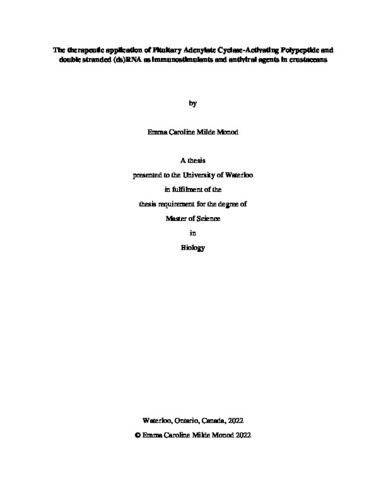| dc.description.abstract | Currently valued at 28 billion USD per year, the global shrimp market is growing faster than any other aquaculture industry. The initial fast-paced global industry expansion led to many catastrophic viral shrimp pandemics. White spot syndrome virus (WSSV), a DNA virus with global distribution, is a major causative agent of massive shrimp die-offs worldwide. Shrimp farmers are limited in their ability to manage and reduce disease burden due to the absence of effective antiviral treatments. The present study focuses on the application of therapeutics in crustaceans with the goal of inducing a general immune response to control viral infection. Double-stranded (ds)RNA has been well characterized in vertebrates as an innate immune stimulant and potent inducer of the antiviral response through type I interferons and interferon stimulated genes. Pituitary adenylate cyclase activating polypeptide (PACAP) is a highly conserved, multifunctional, cationic neuropeptide with antimicrobial properties. In vertebrates PACAP has been shown to regulate pro- and anti-inflammatory cytokine production through cAMP signalling cascades and to interfere directly with viral protein transcription. In this study, wild caught Ontario crayfish were injected with 10 µg of High molecular weight (HMW) Polyinosinic:polycytidylic acid (synthetic dsRNA), a low (6 µg) and high (12 µg) dose of PACAP-38 and a combination of 10µg Poly(I:C) HMW and 12µg PACAP-38. The safety of these treatments was first established through exposure of primary hemocytes in vitro to concentrations of PACAP between 1.95 and 250nM and Poly(I:C) HMW between 0.0076 and 10µg/mL which did not reduce cell metabolism or membrane integrity. These therapeutics were then delivered to crayfish by both intramuscular and ventral sinus injection. Following treatment for 6-, 24-, 48- and 168-hours immune system activation was measured using functional markers of cellular and humoral responses, including the total number of hemocytes, lectin activity, nitric oxide concentration and activated phenoloxidase function. Following in vivo stimulation by ventral sinus injection, animals treated with Poly(I:C) HMW, PACAP and the PACAP+HMW combination had a higher total number of hemocytes and a significant increase in hemagglutination and phenoloxidase activity between 6 and 168 hours. PACAP treatment for 6 hours resulted additionally in a significant increase in the hemolymph concentration of nitric oxide. This work establishes the immunostimulatory role of dsRNA and PACAP-38 in crustaceans which will benefit the shrimp aquaculture industry by contributing to the development of effective broad-spectrum immune therapies. | en |

